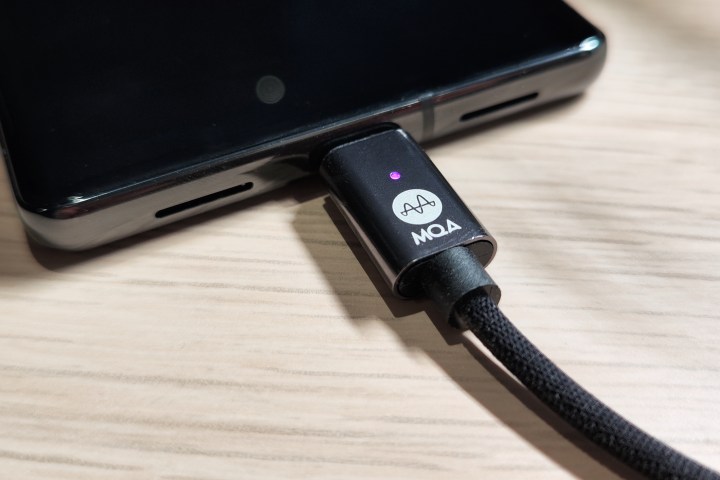
When it comes to discussions of digital audio, you’ll quickly run into an alphabet soup of acronyms: MP3, AAC, ALAC, FLAC, WAV, DSD, and so on. It’s practically endless.
- What is MQA?
- What makes an audio file ‘authentic?’
- De-blurring the time-domain
- Music origami
- CD quality and hi-res quality in a single file?
- Impossibly small files
- Where can I stream or download MQA songs?
- Software and hardware
- What do those color LEDs mean?
- MQA quality won’t translate over Bluetooth (yet)
- How does MQA sound?
- About MQA the company
You’d think that with this many digital audio file types, we wouldn’t need yet another. However, there is one more digital audio file you need to know about. It’s called MQA.
The claims for MQA are impressive. It’s an audio format that can be downloaded, streamed, or even played from a CD, and yet it’s also purportedly capable of delivering hi-res audio from a file that’s less than half the size of other formats. Its creator also says that when you listen to MQA, you’re getting exactly what the artist intended because once an MQA audio file leaves the studio, it’s never touched again by the artist’s label, a streaming service, or any other third party.
Can it really do that? How can you hear MQA for yourself? And why is Neil Young so angry at MQA that he pulled his entire catalog from Tidal in protest? We’ll cover all of that and more but be prepared for an adventure — the MQA story is a complicated one.
What is MQA?
MQA stands for Master Quality Authenticated and is the name of an audio format and a collection of licensed technologies for working with that format. It’s also, somewhat confusingly, the name of the company that originally developed and licensed those technologies. That company was founded by Bob Stuart — the same person who founded the U.K. audio firm Meridian Audio and invented MLP, the lossless audio technology at the heart of DVD and Blu-ray audio — but all of its assets were recently acquired by Lenbrook, the Canadian owner of Bluesound, NAD, and PSB Speakers. Since the acquisition is still very new and many details about how the business side of MQA will evolve over time are still unknown, this explainer still refers to Bob Stuart and MQA (the former company) as the primary sources of info on MQA. We will update this article as these details emerge.
For now, we’ll stay focused on MQA, the audio technology.
The MQA audio format has several elements that make its creators believe it’s unique:
- During the creation of an MQA file, filtering and processing are applied to correct a problem that can happen to any digital audio, known as time-domain smearing. MQA calls it “de-blurring.”
- The files are about the same size as a lossless, CD-quality FLAC file, and yet Stuart claims that through a process called music origami, it can deliver sound quality that is comparable to a much larger, hi-res lossless FLAC file — if the source itself is hi-res.
- An MQA file (or stream) possesses a type of digital fingerprint. When the file is received and processed by compatible audio gear, this fingerprint acts as a kind of authentication, letting listeners know that they’re hearing the same version that the artist or engineer created in the studio. We’ll discuss why this might matter to you later.
- MQA only allows MQA-approved and licensed devices to fully decode MQA tracks. Stuart says it’s a necessary step in order to address the processing differences between various digital-to-analog converters (DACs).
What makes an audio file ‘authentic?’
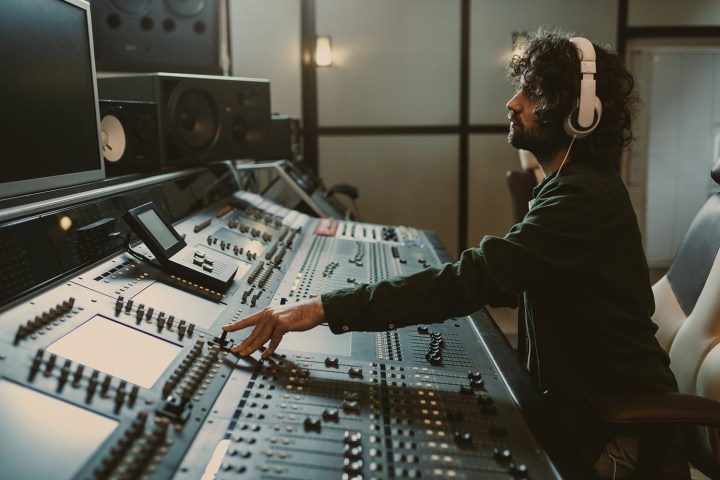
Your first reaction to the notion of authenticated audio files might be to roll your eyes. After all, if you can hear the song you wanted, does it really matter if it’s been authenticated?
MQA argues that it does. Stuart claims that most of the digital music we stream or download is not the direct product of the artists themselves. Using the studio masters, a variety of versions get created, often by third parties. Artists and their producers rarely get a chance to hear these versions before they’re made available to the public, which creates the possibility that the songs no longer sound the way they did in the studio.
Because MQA files are digitally signed when they’re created in the studio, it means two things. First, when the artist creates an MQA file, they can preview what it will sound like on a variety of different playback devices. If they don’t like what they hear, they can try again. Second, the MQA file you receive is the exact same file that the artist signed, and if you have compatible software or hardware you can even see a color-coded version of the digital signature (we’ll discuss these color codes later).
MQA critics argue that while this authentication angle is a legitimate benefit, too often MQA files are not created by the artist or even an engineer, which undermines the value of authentication. Some critics have also suggested that it’s surprisingly easy to alter the contents of an MQA file without disrupting its digital signature.
De-blurring the time-domain
In the process of digitizing analog audio, filters are applied which can cause something known as time-domain smearing. It’s a slight reduction of the speed at which some frequencies are processed. The result is an audio signal that is less accurate to the original source material. Performing the conversion back to analog can, in some cases, make this smearing worse. We’re talking extremely tiny fractions of a second, but the working theory is that our brains can detect it and we prefer how music sounds when this smearing isn’t present (or is at least greatly reduced).
Whether you agree with this theory or not, Stuart says time-domain smearing can affect any digital audio — including CD audio — not just streaming digital music. Because the MQA encoding process includes additional filters designed to correct smearing, Stuart claims this process, which he calls “de-blurring” makes MQA — even without its other claimed benefits — a better-than-CD-quality format.
If you’ve got the time (and the patience), SoundOnSound has an incredibly in-depth look at MQA, including all of the details of time-smearing.
Music origami
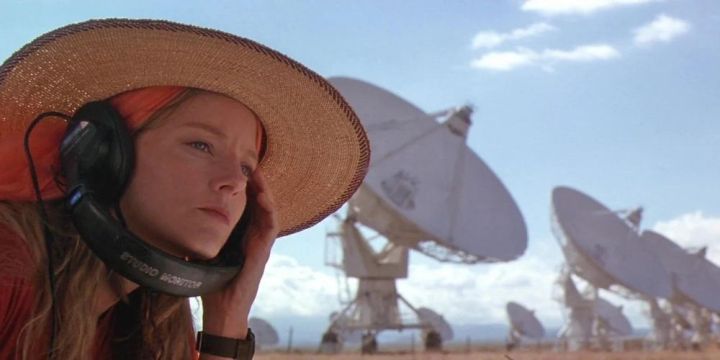
There’s a great scene in the 1997 movie Contact where astronomers figure out that a mysterious transmission from outer space is actually an encoded signal of one of the first human TV broadcasts (eerily, a 1936 recording of Hitler from the Olympic Games). Not long after that initial discovery comes a second, more profound revelation: Hidden in the broadcast is a set of encoded instructions for building a machine that will let humans meet the species that sent the signal in the first place.
An MQA audio file works similarly. When you download or stream MQA, you’re actually downloading or streaming a 24-bit file in one of three common lossless file types: FLAC, ALAC, or WAV. Thanks to some clever engineering, these 24-bit files can still be played by equipment that is limited to 16-bit playback, like a CD player or a non-hi-res digital audio player.
If the original master recording only exists as a CD-quality, 16-bit/44.1kHz file, there are effectively no audio benefits to the MQA version other than the claimed improvements of de-blurring. They can, however, with additional software or hardware, be authenticated.
If the original master recording exists as a hi-res file, the MQA format can include that extra info too — without making the file itself any larger — which can later be extracted if you have MQA-compatible software or audio equipment. Stuart calls this hiding of extra info “music origami” (after the ancient Japanese art of paper folding).
CD quality and hi-res quality in a single file?

In the MQA world, each audio file contains three levels of information. When MQA files are created in the studio, the second and third levels (regions B and C in the diagram above) are encoded and stored in an area of the recording that contains volume levels far below the range of human hearing. If they’re present in the master recordings, these are the portions that make an audio file hi-res, as opposed to simply CD-quality.
A quick note on these diagrams: They represent the audible frequencies captured during studio recording. This is different than the sampling frequency (rate) used when that recording was digitized, even though audible frequencies and sampling rates are both expressed as kilohertz (kHz).
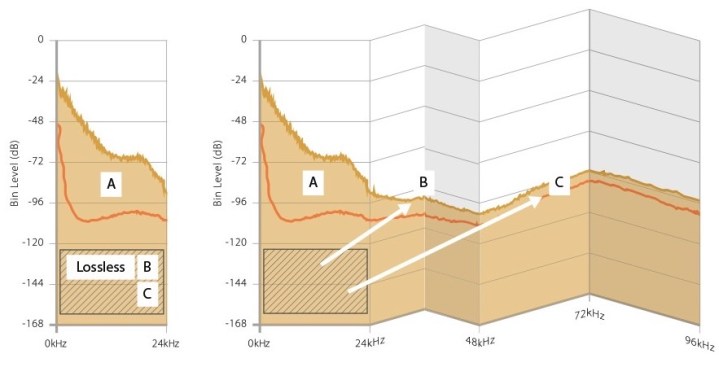
The decoding of each level is known as an unfold. The first and arguably most important unfold can be performed by software or hardware, but the second and third unfolds can only be performed by MQA-compatible hardware. We’ll discuss the software and hardware more in a moment.
The first unfold extracts both additional bit-depth and sample rate, bringing the audio back up to hi-res quality with a sample rate of either 88.2 or 96kHz.
At this point, you can use any DAC to convert the digital audio into analog audio so you can listen to it. However, if you possess MQA-compatible hardware, the MQA stream can proceed to the second and third unfolds, which resurrect the remaining hidden audio information.
These final unfolds also let you hear the original sample rate if it was higher than the 96kHz supported by the first unfold. Stuart says that while three unfolds are typical, many more unfolds can be added. If the original sample rate was 768kHz (for example), 16 unfolds are used.
Impossibly small files

If you’re familiar with hi-res audio, you may be wondering why anyone would go to all of this trouble folding up extra information in a CD-quality file when both FLAC and ALAC (and DSD) are all capable of delivering 24-bit/192kHz-or-better, lossless hi-res audio?
One reason is size. MQA illustrates the difference in file sizes using Madonna’s Like A Virgin. When that song is encoded into a lossless, hi-res FLAC file at 24/192, it ends up as 135.3 MB. The MQA FLAC file comes in at just 46.2 MB — roughly the same size as a 16-bit/44.1 lossless FLAC file.
If you believe Bob Stuart’s claim that the MQA FLAC file will sound as good or better than the lossless, hi-res FLAC file at 24/192, MQA becomes a no-brainer for a streaming service like Tidal, which gets to promise its customers hi-res audio while only paying for a third of the bandwidth per song that Apple Music or Amazon Music must pay when you stream lossless hi-res tracks from those services.
However, this is where we get into the first of several controversies that have dogged MQA since it began: mathematically, a lossless hi-res FLAC file and an MQA file are not the same. The MQA encoding process makes some qualitative judgments about which parts of the original recording can be safely discarded without altering the sound. Technically, this makes MQA a lossy form of compression.
The debate then becomes a question of whether or not there’s such a thing as a lossy format that can sound as good (or possibly better) than a genuinely lossless format. Needless to say, MQA’s supporters think the answer is yes, while many die-hard members of the audiophile community reject such a notion, claiming that any loss of information from the original recording is an unforgivable sin.
Neil Young might be the most famous person among the anti-MQA crowd. In a 2021 blog post on his site NeilYoungArchives, the folk singer wrote “MQA is the company supplying technology to Tidal. In their own official descriptions, they go into what they did to my original files. They altered them and charge a royalty. I feel that my master files are in no way improved. They are degraded and manipulated. I made them. I know the difference. I can hear it.”
Where can I stream or download MQA songs?
Tidal’s HiFi Plus subscription tier, which is currently $20 per month, is by far the easiest way to get your hands (and ears) on MQA. Tidal has millions of tracks in its so-called “Tidal Masters” collection, and it adds many new albums in MQA format every week. However, in April 2023 Tidal announced that it would begin adding hi-res lossless FLAC versions of tracks to its HiFi Plus tier, and has since started replacing MQA versions of its song catalog with FLAC versions. Though Tidal hasn’t said it plans to eliminate MQA, if the current trend continues, the format will effectively cease to exist on the service within a few years.
Nugs.net is the other streaming service that supports MQA. Unlike Tidal, which focuses primarily on studio recordings, Nugs.net is the place for live music fans to get their favorite performances streamed in MQA.
Radio Paradise recently adopted the MQA format for its four mixed channels, though the MQA streams are exclusive to Bluesound’s BluOS devices for the moment.
Streaming may be the easiest way to hear MQA, but these sites are the place to go if you prefer to own and download your music:
- 2L, a Nordic label specializing in classical, jazz, and folk
- e-onkyo music, a Japan-based music download site (currently limited to residents of Japan, unfortunately)
- HDTracks, probably the largest catalog of downloadable MQA content
- Nugs.net doesn’t just stream live music, it also offers downloads
- HighResAudio, a Germany-based site for all hi-res formats
- Sony Music Select maintains a hi-res audio catalog with MQA support
Finally, if you have a CD player or a CD drive you can use to rip CDs to your computer, an MQA CD might be the way to go. They’re not exactly easy to come by, but if you’re prepared to do some hunting, start here: Amazon, Japan-CD.com, and eBay.
Software and hardware

Here’s what you need to know about the gear required to listen to MQA.
As we mentioned in the music origami section, undecoded MQA files can be played by a wide variety of hardware and software. MQA CDs will work in any CD player. And if you downloaded an MQA track from a music download site in FLAC format, any software on your phone or computer that can play FLAC files will be able to play them.
However, if you want to unlock the additional info tucked away inside an MQA file and/or if you want to see authentication confirmation indicators, you’ll need some specific hardware and/or software.
MQA’s requirements start with the first unfold, which decodes a portion of the hidden info known as the MQA Core. Either software or hardware can be used to perform this first unfold.
From a software perspective, Android users can download USB Audio Player Pro, while Mac and PC users can subscribe to either Roon or Audirvana — two paid digital music playback platforms. If you’re only interested in streaming MQA, the Tidal app on Android, iOS, PC, and macOS, and the Nugs.net mobile app for iOS/Android can also perform the MQA Core decode.
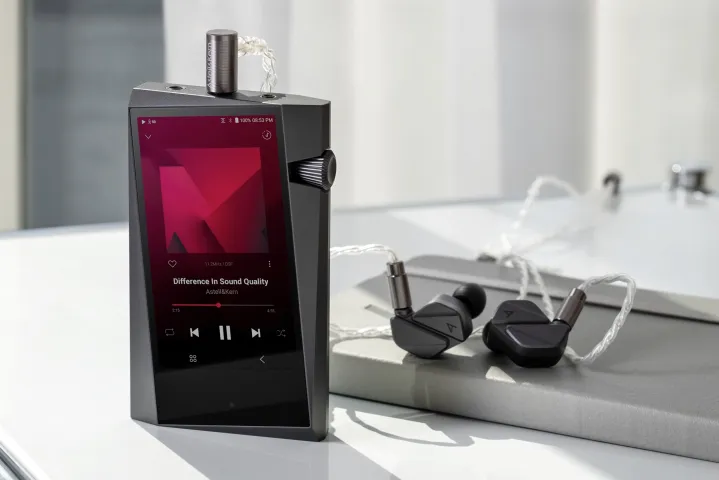
On the hardware side, only a category of devices known as full MQA decoders can perform the MQA Core unfold. They can also perform the additional second and third (or more) unfolds, which makes these devices the preferred choice for audiophiles. These full decoders come in a variety of shapes and sizes. Astell&Kern’s portable digital audio players are full decoders, as is the Ifi Go Bar DAC/headphone amp which can plug into any computer or smartphone. You’ll also find full decoders in audio receivers, hi-fi DACs, and network media streamers like Bluesound‘s collection of wireless multiroom audio products.
There’s also a hybrid approach. If you choose to use a software decoder for the first unfold, it can send that MQA Core signal to one of the hardware devices listed above, or you can opt for a dedicated (and usually more affordable) device known as an MQA renderer. Renderers, like the very reasonably-priced Ifi Go Link ($59) need to have the first MQA unfold performed by software, but once they receive the MQA Core signal they can perform the additional unfolds.
Bob Stuart says that this hybrid approach will let you hear MQA files at their maximum quality, but he still maintains that full decoders offer an improvement in sound quality.
One thing that MQA renderers can’t do is offer the authenticity component of the MQA experience. Because they don’t perform the first unfold, there’s the possibility that the MQA Core signal they’re working with did not originate with the creator. It’s also impossible for a renderer to know if it’s working with the original sample rate.
What do those color LEDs mean?

Although the magenta-colored LED light is the one you’ll most commonly see on MQA-compatible rendering devices like DAC/amps, there are actually several LED colors associated with MQA. Here’s what they mean:
Green: This is used by software or hardware that can perform the first MQA unfold (MQA Core). It tells you that even though the MQA file being decoded can be authenticated, the recording engineer hasn’t declared the track to be the definitive version of the recording.
Blue: This is used by software or hardware that can perform the first MQA unfold (MQA Core). It indicates an MQA Studio track, which in addition to being authenticated, is also considered the definitive version of the recording. According to Bob Stuart, “The sound you are hearing is exactly as played in the studio when the music was completed.”
Magenta: This is used by an MQA hardware renderer (or a full decoder) when these devices receive an MQA Core stream from an app or another hardware device that has performed the first unfold. It indicates that the stream has been correctly encoded as an MQA file, but it cannot authenticate it or tell you if it is an MQA Studio track.
MQA quality won’t translate over Bluetooth (yet)
Sadly, because the MQA format must remain intact until it is converted into analog audio you can hear, Bluetooth wireless speakers and headphones, as well as true wireless earbuds, can’t join the full MQA party. That’s because Bluetooth itself needs to perform digital re-encoding to send wireless audio from your phone to your headphones. This re-encoding disrupts the carefully folded MQA data, making it unavailable to your ears.
You can still enjoy the benefits of the first MQA unfold using Bluetooth, but the hi-res experience is not yet an option.
This may change in the future. MQA (the company) announced in 2022 that it had created a new Bluetooth-compatible codec known as MQair. Among the improvements that MQA claims MQair possesses over competing codecs like Qualcomm’s aptX Adaptive or LE Audio’s LC3, is that it can keep MQA (the format) intact over a Bluetooth connection.
Since that announcement, MQA has decided to market MQair under its technical name instead: SCL6. Despite the fact that SCL6 has been granted a wireless hi-res audio certification from the Japan Audio Society, so far, no manufacturers have included SCL6 support in their audio products. Still, Lenbrook cited SCL6 as a key MQA asset when it announced its acquisition of MQA.
How does MQA sound?
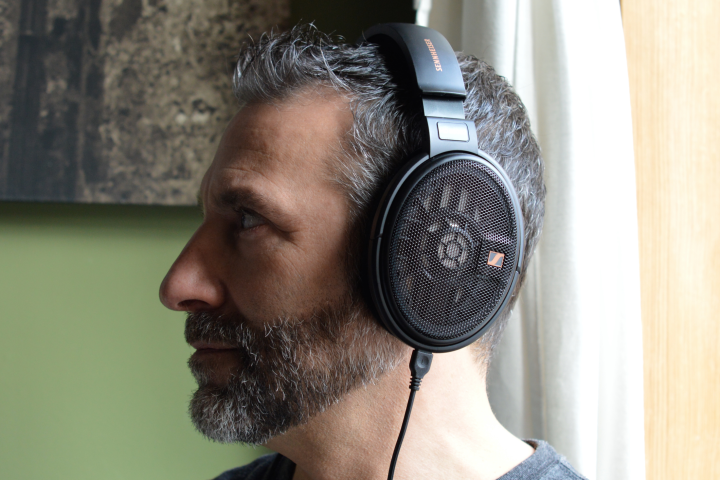
If you go to the trouble of signing up for an expensive streaming plan and buying the necessary hardware to play MQA tracks in their full quality, will you hear a difference? Probably. Will you like what you hear? That’s a tougher question to answer.
For me, the answer is yes. Well, mostly yes.
Using an iPhone 14 with Tidal HiFi and Apple Music, an Ifi Go Link DAC, and a set of Sennheiser HD 660S2 open-back headphones, I went back and forth between the lossless CD-quality and MQA versions of dozens of artists’ tracks. I sampled Green Day, Led Zeppelin, The Who, R.E.M, Heart, John Coltrane, Beck, and Billie Eilish, to name just a few.
The results? I thought the MQA version of most tracks was noticeably better, and not just by a small amount. MQA allowed each instrument and each voice to inhabit its own space, adding both depth and clarity. In some cases, like the Red Hot Chili Peppers’ Snow (Hey Oh), the additional detail is striking, particularly as the song evolves from a single instrument to the full arrangement. You can continue to hone in on that first guitar riff even as it becomes just one of many overlapping sounds.
However, not all tracks benefit from the MQA treatment. I was hard-pressed to notice a significant difference when listening to most of Tom Petty’s songs. Older tracks by The Who like Pinball Wizard and Baba O’Riley were similar. I noticed a small improvement, but only just.
As with all discussions of audio, whether it’s a format like MQA or a new set of headphones, the only way to know if you can hear a difference is to try it for yourself.
About MQA the company
Until 2023, there wasn’t that much to say about the corporate entity known as MQA, other than it owned and licensed the MQA technology to the various industry players that use it. However, in early 2023, MQA announced that it had entered into administration — a British version of Chapter 11 — after losing one of its largest financial backers. This prompted MQA to seek a buyer, which it eventually found in Lenbrook in September 2023.
The acquisition brings some short-term stability to the MQA ecosystem as there’s no longer the threat of insolvency or dissolution of the company that owns the intellectual property tied to MQA’s portfolio of codecs and other assets. However, the situation with Tidal remains a problem. As the single biggest source of MQA content, if Tidal continues to make MQA versions of its song library unavailable to subscribers, Lenbrook will need to strike a new deal with another streaming service or potentially start its own.
We’ll update this explainer as we learn more.
Editors' Recommendations
- What is Tidal? The hi-fi streaming music service fully explained
- Ifi says its latest portable DAC restores the missing quality in digital audio
- What is Auracast? The Bluetooth broadcast standard fully explained
- Earfun makes hi-res audio more accessible with affordable earbuds and DAC
- The Canadian company that owns NAD and Bluesound now owns MQA




